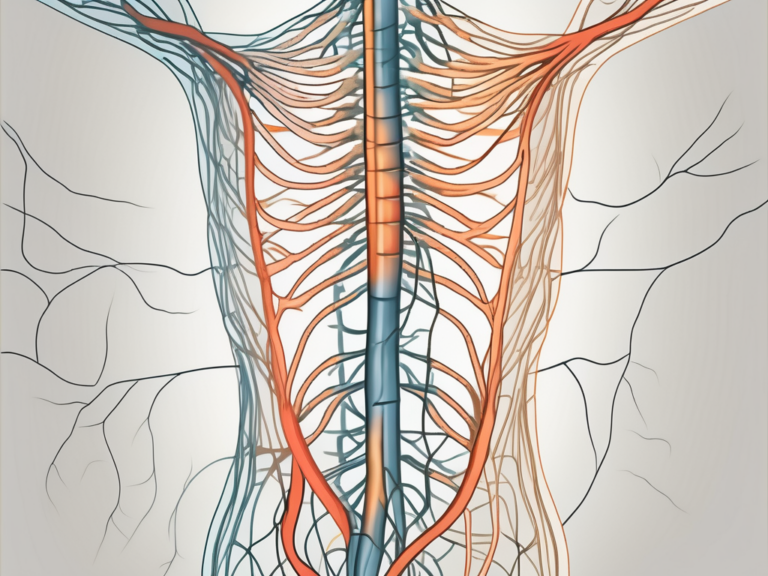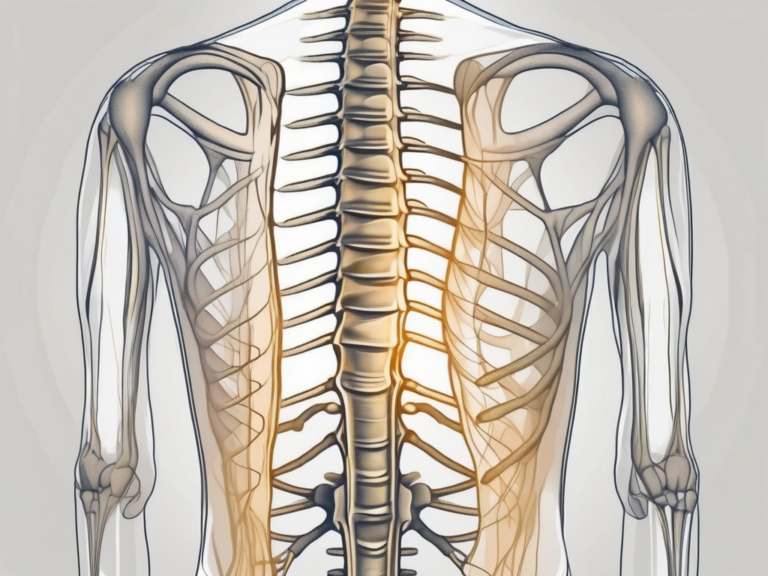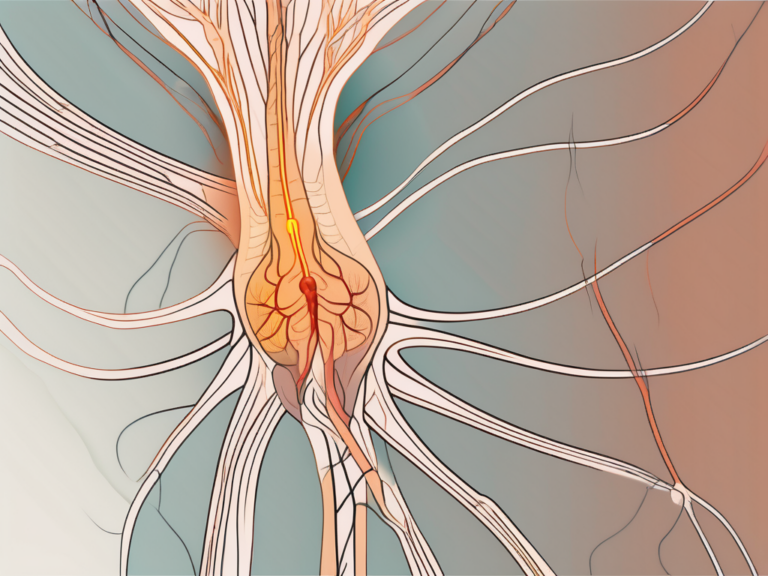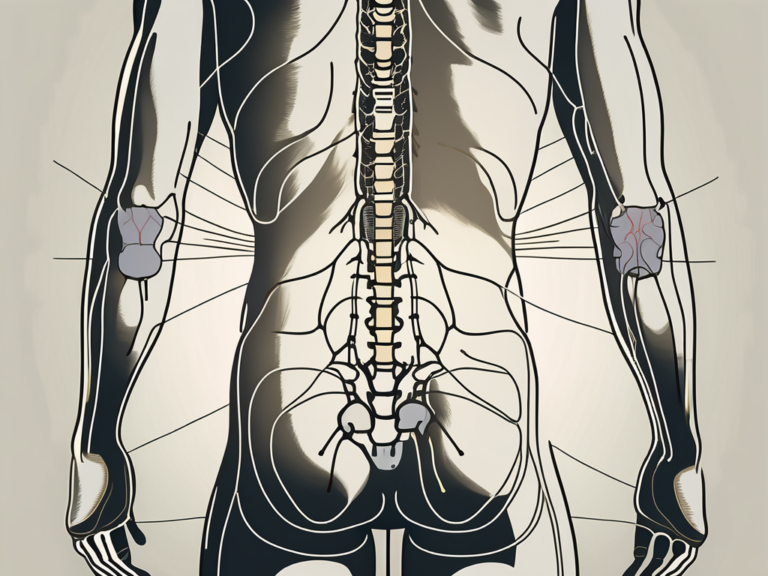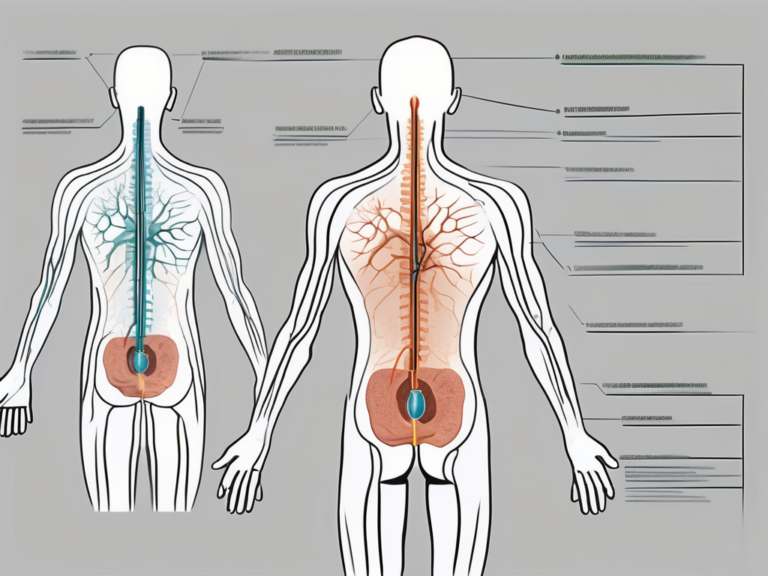Where Is the Sacral Nerve Located?
The sacral nerve is an essential component of the human nervous system, playing a crucial role in various body functions. To understand where the sacral nerve is located, it is important to first comprehend the intricacies of the nervous system as a whole.
Understanding the Human Nervous System
The human nervous system is a complex network of specialized cells called neurons, which transmit electrochemical signals to and from the brain and other parts of the body. It can be divided into two major divisions: the central nervous system (CNS) and the peripheral nervous system (PNS).
The central nervous system (CNS) is the control center of the body. It consists of the brain and spinal cord, which work together to process and coordinate information. The brain is responsible for higher cognitive functions such as thinking, memory, and emotions, while the spinal cord serves as a pathway for transmitting signals between the brain and the rest of the body.
The peripheral nervous system (PNS) is like a communication network that connects the CNS to the muscles, organs, and sensory receptors throughout the body. It consists of nerves, which are bundles of specialized cells that carry information to and from the CNS. The PNS can be further divided into the somatic nervous system and the autonomic nervous system.
The Role of Nerves in Body Functioning
Nerves are the fundamental building blocks of the nervous system and are responsible for carrying information between the brain, spinal cord, and the rest of the body. They enable vital functions such as movement, sensation, and the regulation of bodily processes.
When you touch something hot, for example, sensory nerves in your skin send signals to your brain, which then interprets the information and sends signals back to your muscles to move your hand away. This rapid communication between nerves allows your body to respond quickly to stimuli and protect itself from harm.
In addition to transmitting sensory information, nerves also play a crucial role in motor function. Motor nerves carry signals from the brain to the muscles, allowing you to move and perform various actions. Whether it’s walking, talking, or even blinking, all of these actions are made possible by the intricate network of nerves in your body.
Major Divisions of the Nervous System
The nervous system comprises the central nervous system (CNS), which includes the brain and spinal cord, and the peripheral nervous system (PNS), consisting of nerves that connect the CNS to the muscles, organs, and sensory receptors throughout the body.
The central nervous system is like the command center of the body. It receives and processes information from the sensory organs and sends out signals to the muscles and organs to initiate appropriate responses. Without the CNS, our bodies would not be able to function properly.
The peripheral nervous system, on the other hand, acts as a communication network that relays information between the CNS and the rest of the body. It consists of two main divisions: the somatic nervous system and the autonomic nervous system.
The somatic nervous system controls voluntary movements and sensory perception. It allows us to consciously control our muscles and respond to external stimuli. For example, when you decide to pick up a pen, the somatic nervous system sends signals to the muscles in your hand to perform the action.
The autonomic nervous system, on the other hand, controls involuntary functions such as heart rate, digestion, and breathing. It operates automatically, without conscious effort. For instance, when you eat a meal, the autonomic nervous system regulates the release of digestive enzymes and controls the movement of food through your digestive tract.
Overall, the human nervous system is a remarkable and intricate system that allows us to interact with the world around us. It enables us to think, move, feel, and experience life in all its complexity. Understanding how this system works is essential for gaining insights into human behavior, cognition, and overall well-being.
Anatomy of the Sacral Nerve
The sacral nerve, specifically, is located in the lower part of the spine, known as the sacrum. It is a critical component of the peripheral nervous system and contributes to numerous bodily functions.
The sacral nerve plays a vital role in the transmission of signals between the brain and various organs and muscles in the lower part of the body. It is responsible for controlling and coordinating movements, sensations, and functions such as bladder and bowel control, sexual function, and lower limb mobility.
Structure of the Sacral Nerve
The sacral nerve is formed by a bundle of nerve fibers that emerge from the spinal cord in the lower back region. These fibers are part of the spinal nerves that originate in the sacral region.
The nerve fibers that make up the sacral nerve are classified as both sensory and motor fibers. Sensory fibers transmit information from the organs and tissues in the lower part of the body to the brain, allowing us to perceive sensations such as touch, temperature, and pain. Motor fibers, on the other hand, carry signals from the brain to the muscles, enabling voluntary movements and reflex actions.
Connection to the Spinal Cord
The sacral nerve is connected to the spinal cord through a series of nerve roots. These roots exit the spine and merge together to form the sacral nerve, which continues its pathway down the pelvis and into the lower limbs.
The nerve roots that contribute to the formation of the sacral nerve originate from the spinal cord’s sacral region. These roots are responsible for relaying signals between the spinal cord and the peripheral nervous system. They serve as a crucial link in the communication network that allows the brain to control and monitor the functions of the lower body.
As the sacral nerve extends down the pelvis, it branches out into smaller nerves that innervate specific muscles and organs. These branches ensure precise and targeted control over various bodily functions, such as the contraction of the pelvic floor muscles during urination and defecation, the relaxation of the bladder, and the activation of the muscles involved in sexual arousal and orgasm.
The sacral nerve’s intricate structure and connections highlight its significance in maintaining proper functioning and coordination of the lower part of the body. Any disruption or damage to this nerve can result in a range of symptoms and impairments, affecting mobility, sensation, and overall quality of life.
Functions of the Sacral Nerve
The sacral nerve plays a crucial role in the functioning of the lower body and contributes to both movement and sensory perception.
The sacral nerve, also known as the sacral plexus, is a complex network of nerves that originates from the lower part of the spinal cord. It is responsible for controlling various muscles and transmitting sensory information from the lower body to the brain.
Role in Lower Body Movement
The sacral nerve is responsible for controlling the muscles in the lower limbs, including the glutes, thigh muscles, and muscles involved in walking, standing, and maintaining balance. It coordinates the signals that enable smooth and coordinated movement.
When you take a step, the sacral nerve sends signals to the muscles in your legs, telling them to contract and relax in a specific sequence. This coordinated movement allows you to walk, run, jump, and perform various physical activities.
Furthermore, the sacral nerve also plays a crucial role in maintaining balance. It receives information from the inner ear, which helps in detecting changes in body position and adjusting muscle activity accordingly. This feedback loop ensures that you can maintain an upright posture and move with stability.
Contribution to Sensory Perception
In addition to its motor functions, the sacral nerve also carries sensory information from the lower body to the brain. It enables the perception of touch, temperature, and pain sensations in the pelvic region and lower extremities.
When you touch a hot surface, the sacral nerve quickly transmits the information to your brain, allowing you to feel the heat and react accordingly. Similarly, it enables you to feel pressure, vibration, and other tactile sensations in the lower body.
The sacral nerve also plays a crucial role in the perception of pain. If you injure your leg or experience any discomfort in the pelvic region, the sacral nerve transmits the pain signals to your brain, alerting you to the problem and initiating a protective response.
Moreover, the sacral nerve is involved in the regulation of bladder and bowel function. It receives signals from the pelvic organs, allowing you to sense the need to urinate or defecate. It also coordinates the contraction of the muscles involved in these functions, ensuring proper elimination.
In conclusion, the sacral nerve is a vital component of the nervous system, contributing to both movement and sensory perception in the lower body. Its role in controlling muscles and transmitting sensory information allows us to perform various physical activities and perceive the world around us.
Conditions Affecting the Sacral Nerve
While the sacral nerve is designed to function optimally, various conditions can impact its health and functioning.
The sacral nerve, also known as the S1 nerve, plays a crucial role in the functioning of the lower body. It is responsible for transmitting sensory and motor signals between the brain and the lower extremities, including the legs, feet, and pelvic organs. However, despite its importance, the sacral nerve is susceptible to certain disorders that can disrupt its normal functioning.
Common Sacral Nerve Disorders
Some common sacral nerve disorders include sacral neuropathy, nerve impingement, and sacral radiculopathy. These conditions can cause symptoms such as pain, numbness, tingling, and muscle weakness in the lower body.
Sacral neuropathy refers to damage or dysfunction of the sacral nerve, often resulting from trauma, infection, or chronic medical conditions such as diabetes. This disorder can lead to a range of symptoms, including shooting pain in the legs, difficulty walking, and loss of bladder or bowel control.
Nerve impingement, also known as nerve compression, occurs when the sacral nerve is compressed or pinched by surrounding structures such as herniated discs, bone spurs, or muscle tightness. This compression can cause radiating pain, numbness, and weakness in the lower back, buttocks, and legs.
Sacral radiculopathy, also referred to as sciatica, occurs when the nerve roots that make up the sacral nerve become irritated or inflamed. This can result from conditions such as a herniated disc, spinal stenosis, or degenerative disc disease. Symptoms of sacral radiculopathy may include pain that radiates down the leg, muscle weakness, and difficulty sitting or standing for prolonged periods.
Symptoms and Diagnosis of Sacral Nerve Issues
Diagnosing sacral nerve issues involves a thorough medical evaluation, including physical examination, imaging tests, and nerve conduction studies. Symptoms may vary depending on the underlying cause, making an accurate diagnosis vital for effective treatment.
During a physical examination, a healthcare provider will assess the patient’s range of motion, reflexes, and sensory responses in the lower body. They may also perform specific tests, such as the straight leg raise test, to evaluate nerve function and identify any areas of pain or discomfort.
Imaging tests, such as X-rays, magnetic resonance imaging (MRI), or computed tomography (CT) scans, may be ordered to visualize the structures surrounding the sacral nerve. These tests can help identify any abnormalities, such as herniated discs or bone spurs, that may be causing nerve compression or irritation.
Nerve conduction studies, also known as electromyography (EMG), are often used to assess the electrical activity of the sacral nerve and surrounding muscles. This test involves placing small electrodes on the skin to measure the nerve’s ability to transmit signals and detect any abnormalities or disruptions in nerve conduction.
Once a diagnosis is made, treatment options for sacral nerve disorders may include medication to manage pain and inflammation, physical therapy to improve strength and mobility, and in some cases, surgical intervention to relieve nerve compression or repair damaged nerves.
In conclusion, the sacral nerve is a vital component of the lower body’s functioning, and various conditions can impact its health and proper functioning. Understanding the common disorders affecting the sacral nerve, as well as the symptoms and diagnostic procedures involved, is crucial in ensuring accurate diagnosis and effective treatment for individuals experiencing sacral nerve issues.
Treatment Options for Sacral Nerve Disorders
Treatment for sacral nerve disorders typically depends on the underlying cause and the severity of symptoms. In most cases, non-surgical interventions are explored before considering surgical options.
Sacral nerve disorders can be debilitating and have a significant impact on a person’s quality of life. It is essential to explore various treatment options to find the most effective approach for each individual.
Non-Surgical Treatments
Non-surgical treatments may include physical therapy, pain medication, nerve blocks, and lifestyle modifications. Physical therapy exercises can help strengthen the sacral nerve and improve overall nerve health.
Physical therapy sessions are tailored to the specific needs of the patient and may include exercises to improve flexibility, strengthen the muscles surrounding the sacral nerve, and promote proper posture. These exercises can help alleviate pain, improve mobility, and enhance overall function.
In addition to physical therapy, pain medication may be prescribed to manage the symptoms associated with sacral nerve disorders. Nonsteroidal anti-inflammatory drugs (NSAIDs) can help reduce inflammation and alleviate pain. In some cases, stronger pain medications, such as opioids, may be necessary for more severe pain.
Nerve blocks, another non-surgical treatment option, involve injecting medication directly into the affected area to block the pain signals from reaching the brain. This can provide temporary relief and allow individuals to engage in physical therapy and other activities without experiencing excessive pain.
Lifestyle modifications can also play a crucial role in managing sacral nerve disorders. These may include maintaining a healthy weight, practicing good posture, avoiding activities that exacerbate symptoms, and incorporating stress-reducing techniques into daily life.
Surgical Interventions for Sacral Nerve Disorders
In more severe cases, surgical interventions may be necessary. These can involve decompression of the nerve, removal of tumors or cysts causing nerve compression, or nerve grafting in cases of nerve damage.
Decompression surgery aims to relieve pressure on the sacral nerve by removing any structures causing compression, such as bone spurs or herniated discs. This can help alleviate pain, improve nerve function, and restore mobility.
When tumors or cysts are causing nerve compression, surgical removal may be required. This procedure involves carefully excising the growth, ensuring that the surrounding nerves are not damaged in the process. The removal of these growths can provide relief from symptoms and prevent further nerve damage.
In cases of nerve damage, nerve grafting may be necessary to restore function. This procedure involves taking a healthy nerve from another part of the body and surgically attaching it to the damaged nerve. Over time, the healthy nerve can help regenerate the damaged nerve and improve overall function.
It is important to note that surgical interventions for sacral nerve disorders carry risks and potential complications. Therefore, thorough evaluation and consultation with a qualified healthcare professional are crucial to determine the most appropriate treatment approach.
Maintaining Sacral Nerve Health
While some conditions affecting the sacral nerve may be unavoidable, there are steps individuals can take to promote overall nerve health and minimize the risk of nerve-related issues.
Lifestyle Changes for Nerve Health
A healthy lifestyle plays a crucial role in maintaining the health of the sacral nerve and the entire nervous system. This includes regular exercise, a balanced diet rich in essential nutrients, adequate sleep, stress management, and avoiding harmful habits such as smoking and excessive alcohol consumption.
Exercises to Strengthen the Sacral Nerve
Engaging in exercises that specifically target the muscles controlled by the sacral nerve can help strengthen its functionality. These may include pelvic floor exercises, yoga, and low-impact activities such as swimming or cycling.
While understanding the location of the sacral nerve is essential, it is equally important to consult with a medical professional for any suspicions or concerns about sacral nerve health. Only a qualified healthcare provider can provide accurate diagnosis and personalized recommendations based on individual circumstances. Take proactive steps to care for your nervous system, and prioritize your overall well-being.
